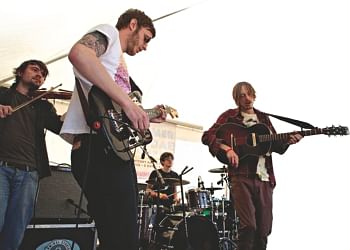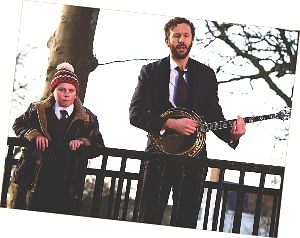GAME REVIEW
 NEED FOR SPEED
NEED FOR SPEED
MOST WANTED 2012
By Shaer Reaz
EA and Criterion Games are back with a new Need for Speed game, and surprisingly, the results aren't half bad. Titled Most Wanted, it's a remake of the 2005 NFS game of the same name. The first Most Wanted was a huge hit and still has a cult following (some call it the best modern NFS game yet), so the new one had a lot to live up to.
The intro gives away the differences straightaway. I didn't want to compare two games coming out 8 years apart, what with huge leaps in game design in recent years, but I'm pretty sure everyone will compare the two at some point in time. All the cars in the game are outwardly stock, a myriad blend of supercars and exotics battling it out with cops and each other in a realistically rendered city. The blacklist returns, but unlike the original NFS-MW, the main heroes are the cars. There are no cheesy dialogue filled cut-scenes or less than believable characters, just a list of the Most Wanted Cars in Fairhaven, your locality. Gather enough Speed Points by winning races and evading police pursuit, then challenge each car to a duel; if you win, you get a chance to wreck the Most Wanted car, after which you can drive it (?!). The cops are pretty easy to beat once you get your hands on some fast cars, but some say it's a lot harder because there are no Pursuit Breakers like in previous games.
The absence of any plot might upset some fans, but once you get into the game, you don't miss it much. Fairhaven is a great place to drive some fast cars, but I would have preferred the free roam map in the Hot Pursuit reboot, which offers a much more open world with scenic views. Fairhaven feels cramped and generic, as often a city does in real life, with the traffic choking the streets and eating up the space. Criterion Games says this game is all about “going for a drive” and enjoying a fantasy life where you can street race with million dollar hypercar Bugattis and Paganis and priceless classics like the Shelby Cobra 427 and the Lamborghini Countach. It really IS all about the drive, as you'll soon learn.
Straight into the game, you will not be comfortable with the way the cars handle. It feels like operating a saw-tooth instead of a virtual steering wheel, the car slicing one way and then the other at the slightest input from the keyboard. Gamers with a wheel or analogue controllers will have fewer problems because of the force feedback, but I don't think they'll appreciate the lack of precision either. You get used to it though, and before long you'll be telling yourself that supercars aren't supposed to be easy to drive and that this game actually has realistic handling. I mean, how would any of us know what it's like to drive a Lamborghini Aventador - or even a Lancia Delta Integrale - at high speeds in a city filled with traffic?
The absence of car customisation (other than performance modifications) is another glaring point that you notice when you start playing the game. Like the handling, this grows on you too. To elaborate, the car customisation in NFS games like Underground and Most Wanted and even newer games like Carbon and ProStreet, were all a bit “ricey”. Filled with giant spoilers, non-functional hood and roof scoops, utterly ridiculous mirrors, tacky stickers and decals and a lot more, older NFS games have a knack for messing up when it comes to exterior modifications. The new game does things right, although I would have preferred a choice over car colour, rather than driving through a workshop and praying for a cool colour.
There's no need to buy cars. You can find all the cars out in the world, parked in locations called Jackspots. Roam around in your car and look for parked exotics, get in, and drive. If you want to change cars, just use Easydrive (Criterion's alternative to proper menus) on the go and jump to your car location. The car list is very good, although a few more Japanese machinery (Honda/Acura NSX would be a lovely addition) would have added a bit more to the game. You also get SUVs and sport trucks in the game, so if you fancy a bit of offroading, just head to Hodges Airfield or any of the numerous construction sites littered around the map. If you're more of a Gymkhana man, grab a Subaru Impreza and find some pillars to do slaloms around. Driving is so much more fun when you're not racing or being chased by cops in this game.
The graphics is the best feature; absolutely stunning city, car models, and gorgeously rendered crashes and damaged car bodies. The traffic in the game is composed of fully licensed cars, adding to the realistic feel. In fact, the traffic is so well rendered, I've mistakenly driven up to cars like the Infiniti G35 and Cadillac CTS, thinking they were Jackspot cars.
The soundtrack is pretty good too, mostly dubstep and remixes that encourage spirited driving. The engine notes amplify when you enter a tunnel while the music steps into the background, letting you enjoy a howling supercar engine. Details like these that make the game endearing.
Don't give up on this game too easily, stick to it for a while, you may come to love it.
ALBUM REVIEW
Dry the River
By Sarah Nafisa Shahid
Through a lucky encounter on a birthday playlist made for me by a dear friend, I came across Dry the River; and I am glad that happened. Like most bands that I have reviewed for RS, Dry the River are an English folk rock band from East London, and yes another addition to the Indie list.
 The band has an overwhelming number of different instruments to their credit: violin, mandolin, tenor horns and more of those exotic kinds. You'd think it would result in an entirely classic Indie-folk music but that's where the band surprises you with occasional punk-rock influences and smooth ballad rock touches here and there. Their lyrics are deep and heart-warming and contain the new-generation approach to self-prophecy. I suppose vocalist Peter Liddle's enthusiasm in anthropology fuels that.
The band has an overwhelming number of different instruments to their credit: violin, mandolin, tenor horns and more of those exotic kinds. You'd think it would result in an entirely classic Indie-folk music but that's where the band surprises you with occasional punk-rock influences and smooth ballad rock touches here and there. Their lyrics are deep and heart-warming and contain the new-generation approach to self-prophecy. I suppose vocalist Peter Liddle's enthusiasm in anthropology fuels that.
Their debut album, Shallow Bed, came out only last April and is a brilliant compilation of 12 tracks. “New Ceremony” is the opening track with a rhythmic guitar plucking which blooms into a catchy, violin and electric guitar concentrated rock song. The band's expertise in writing charming lyrics is displayed in songs like “History Books” and “Lion's Den”. “No Rest” being already popular as an EP is according to me, the best song by the band till now. Front man Liddle's vocals sound magnificent in this one and the track displays the skills of the entire band excellently, with strong lyrics, great bass line and violinist Harvey giving an orchestral feel, making a song which will stay with you for long.
Dry the River has every potential to make it big in the future. So, if you are fond of being a hipster, you could always brag about how you listened to them back when they were just a tiny Indie band, which is now.
MUST LISTEN TRACKS
NO REST * DEMONS * SHIELD YOUR EYES * HISTORY BOOKS
SIMILAR TO DRY THE RIVER
MUMFORD AND SONS * BON IVER
memrise
By Anashua
When I heard about the website that could supposedly teach you a language in a matter of days, I put it in the same category as the life changing yoga lessons and quick weight loss solutions. But then again, I was reading about it in The Guardian, and personally knew someone who started doing a course and getting obsessive about it. So I signed up with Facebook and started a course. The website, Memrise was created by Ed Cooke, a British memory champion and a Princeton neuroscience PhD.
 It uses a mnemonic technique used in ancient Greece, where you associate everything you learn with a picture, rhyme or trivia called a 'mem' that's easy to remember. Like when they teach you the French word 'limoger', meaning 'to dismiss', they show you a picture of Shrek, the lime ogre. Your brain learns to associate the word 'dismiss' with 'lime ogre' and you instantly remember 'limoger'. It has an algorithm that repeats the words you learn at an interval, so your just when the memory starts to dim, your brain reignites it.
It uses a mnemonic technique used in ancient Greece, where you associate everything you learn with a picture, rhyme or trivia called a 'mem' that's easy to remember. Like when they teach you the French word 'limoger', meaning 'to dismiss', they show you a picture of Shrek, the lime ogre. Your brain learns to associate the word 'dismiss' with 'lime ogre' and you instantly remember 'limoger'. It has an algorithm that repeats the words you learn at an interval, so your just when the memory starts to dim, your brain reignites it.
Technicalities aside, the website looks a lot like you're playing an online game, with neat levels which you complete in three steps - by planting a seed, harvesting and finally flowering it. Then you pop in from time to time to water the flowers and revise the words you learnt because Memrise sends you a notification every time their algorithm says your memory's about to dull. The site's designed in a way that makes cramming everything at once difficult; it requires you to spend time in short 10-15 minutes sessions every day. The site looks so friendly it doesn't even feel like you are studying. And you even feel good about it afterwards. It also has a point award system and leaderboard to make it more fun and game-like.
The courses it offers are not restricted to language, they can be on anything you can learn from reading. There are courses to learn Mandarin, Art History, Geography, Maths and even musical notations. Most of the courses are short, around an hour or two, but there are some longer ones, like the popular 75 hours SAT course. I started doing a French course of 1500 words, and I learnt about 50 without feeling like I've spent hours in front of the dictionary. Though it's not possible to learn the grammar of a language like this, the words come with example sentences from which you can get a good idea about how the sentences are made, and you can learn a lot of a language by just learning the vocabulary and phrases. So instead of wasting your hours playing Angry Jolil (yes, that's the new Angry Bird now), try getting hooked to Memrise. It's worth it.
MUST WATCH TV
 MOONE BOY
MOONE BOY
By Orin
When you think about it, being twelve is one of the best things that could possibly happen to a person. Being old enough to understand things but young enough to still be unharmed by teenage - twelve is probably the best time of our lives. Chris O'Dowd, who played Roy in The IT Crowd, made a series about just that. Set in the Bristol of 1989, this is the story of a boy growing up with three sisters, overcooked vegetables, a school full of whackos and an imaginary friend.
Martin Moone is like an amalgamation of all well-meaning and imaginative boys. He loves roaming around his own little world, where breaking down a boundary wall - to go to school faster all by himself - sounds like a good bargain. Living with three older sisters have not made his life very enviable either, not to mention his everyday activity in school that somehow always manages to earn him the rights of being a sitting target for the bullies. Martin survives with the help of random doodling in his notebooks and Sean - his banjo playing one-man chorus of an imaginary friend who somehow consistently manages to give him the worst advice possible in every situation. Moone Boy is nostalgic without going on and on about how great the previous decades were and it is, in places, effortlessly funny.
 The episodes don't really have any real flow, like most British TV shows, and season one has only six episodes, which you'll finish in no time. The acting is decidedly very good. David Rawle plays the ups and downs of Martin Moone in such a natural way that you'd start liking him (and envying him) in no time. Chris O'Dowd playing Sean is all that you'd want in an imaginary friend; he loves your every decision, talks you through when you are afraid and is with you when no one else is.
The episodes don't really have any real flow, like most British TV shows, and season one has only six episodes, which you'll finish in no time. The acting is decidedly very good. David Rawle plays the ups and downs of Martin Moone in such a natural way that you'd start liking him (and envying him) in no time. Chris O'Dowd playing Sean is all that you'd want in an imaginary friend; he loves your every decision, talks you through when you are afraid and is with you when no one else is.
The whole thing has kind of a Calvin and Hobbes and About a Boy feel to it, and we love that. It might not be laugh out loud funny, but it is very good, looks promising and definitely worth the time.
